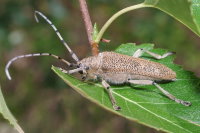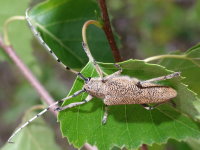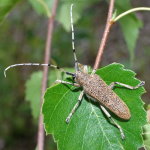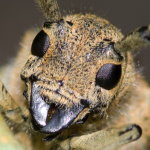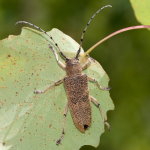Phylum Arthropoda (Arthropods) ➔ Subphylum Hexapoda (Hexapods) ➔ Class Insecta (Insects) ➔ Order Coleoptera (Beetles) ➔ Family Cerambycidae (Longhorn beetles)
Saperda carcharias (Linnaeus, 1758)
Großer Pappelbock Poplar Longhorned Beetle
Synonyms and other combinations:
Anaerea carcharias Bouget & al., 2005 | Anaerea carcharias Chinery, 2012 | Anaerea carcharias Inglebert, 2002 | Anaerea carcharias Kovács, 1998 | Anaerea carcharias Küster, 1846 | Anaerea carcharias Villiers, 1978 | Anærea carcharias Mulsant, 1839 | Anærea carcharias grisescens Mulsant, 1839 | Cerambyx carcharias Linné, 1758 | Cerambyx carcharias Linné, 1761 | Cerambyx carcharias Linné, 1767 | Cerambyx carcharius Schrank, 1781 | Cerambyx (Saperda) carcharias Gmelin, 1790 | Saperda (Anaerea) carcharias Goggi, 2006 | Saperda (Anaerea) carcharias Goggi, 2007 | Saperda (Anærea) carcharias Marquet, 1899 |
Further vernacular names:
Large Poplar BorerClassification:
Saperda carcharias belongs to the subfamily Lamiinae, tribe Saperdini.Distribution and habitat:
The Poplar Longhorned Beetle is widespread in Europe and populates various habitats in which poplars can be found.Description:
Saperda carcharias is with 20 - 30 mm the largest species of the genus in Europe. The beetles have dense yellowish or greyish hairs. The wing covers have a small tooth-like tip at the end. The segments of the long antennae are ringed in black at the end, except for the last one, which is uniformly grey.Similar species:
A similar species is the smaller Saperda similis (15 - 22 mm) with wing covers rounded at the end.Biology:
The beetles can be found on poplars from June to September. An indication of the presence of Saperda carcharias are poplar leaves with more or less large feeding holes with frayed edges. From mid-July, after completion of ripening and mating, the females begin to lay their eggs. The eggs are laid individually in the foot area of young poplars. After a diapause, the wintered eggs develop further the following spring. After hatching, the larvae feed mines into the wood and become up to 4 cm long. They pupate after 2 years under the bark.The larvae can cause great damage, especially to young trees.
References, further reading, links:
- Tavakilian G. & Chevillotte H. (2019). TITAN: Cerambycidae database (version Apr 2015). In: Species 2000 & ITIS Catalogue of Life, 2019 Annual Checklist (Roskov Y., Ower G., Orrell T., Nicolson D., Bailly N., Kirk P.M., Bourgoin T., DeWalt R.E., Decock W., Nieukerken E. van, Zarucchi J., Penev L., eds.). Digital resource at www.catalogueoflife.org/annual-checklist/2019. Species 2000: Naturalis, Leiden, the Netherlands. ISSN 2405-884X.
- Harde, Severa: Der Kosmos Käferführer: Die Käfer Mitteleuropas, Franckh-Kosmos Verlags-GmbH & KG, Stuttgart, ISBN 3-440-07682-2.
- Arved Lompe: Die Käfer Europas - Ein Bestimmungswerk im Internet
- Klaus Hellrigl (2012): Xylotrechus Chevrolat 1860 und Saperda Fabricius 1775 (Coleoptera, Cerambycidae) in Südtirol. – Forest Observer – 006: 239 - 272.
- Acanthocinus griseus
- Agapanthia intermedia
- Brachyta interrogationis
- Callidium aeneum
- Cerambycidae sp.
- Gaurotes virginea
- Grammoptera abdominalis
- Leptura aethiops
- Oberea oculata
- Obrium cantharinum
- Oxymirus cursor
- Phytoecia nigricornis
- Stenostola sp.
- Tetrops sp.
- Xylotrechus arvicola
- Aspen Zebra Beetle
- Black Longicorn Beetle
- Black-striped Longhorn Beetle
- Blood-red Longhorn Beetle
- Common Grammoptera
- Fairy-ring Longhorn Beetle
- Four-banded Longhorn Beetle
- Golden-bloomed Grey Longhorn Beetle
- Hazel Longhorn Beetle
- Ladder-marked Longhorn Beetle
- Large Black Longhorn Beetle
- Lesser Capricorn Beetle
- Lesser Thorn-tipped Longhorn Beetle
- Lime Beetle
- Musk Beetle
- Paterson's Curse Stem Beetle
- Pine Sawyer Beetle
- Poplar Longhorned Beetle
- Red-brown Longhorn Beetle
- Ribbed Pine Borer
- Rufous-shouldered Longhorn Beetle
- Six-spotted Longhorn
- Small Poplar Borer
- Speckled Longhorn
- Spotted Longhorn
- Spruce Shortwing Beetle
- Tobacco-coloured Longhorn
- Variable Longhorn Beetle
- Violet Tanbark Beetle
- Wasp Beetle
- White-clouded Longhorn Beetle
